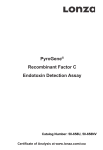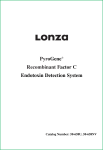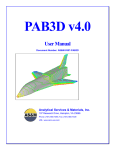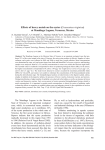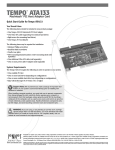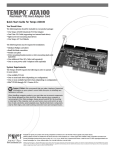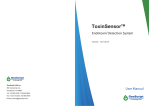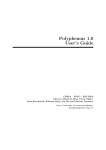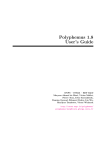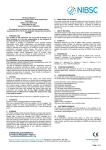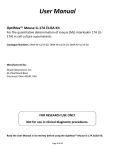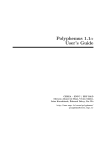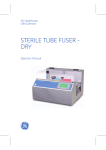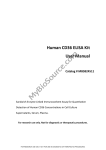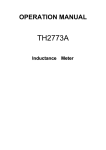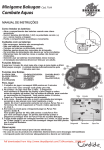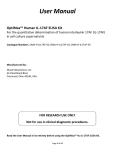Download PyroGeneTM Recombinant Factor C Endotoxin Detection Assay
Transcript
PyroGeneTM Recombinant Factor C Endotoxin Detection Assay Catalog Number: 50-658U, 50-658NV Certificate of Analysis at www.lonza.com/coa 50-658U-11-05 12/2/05 11:02 AM Page 2 TABLE OF CONTENTS TITLE PAGE Intended Use . . . . . . . . . . . . . . . . . . . . . . . . . . . . . . . . . . . . . . . . . . . . . . . . . . .3 Warning . . . . . . . . . . . . . . . . . . . . . . . . . . . . . . . . . . . . . . . . . . . . . . . . . . . . . . .3 Safety Precautions . . . . . . . . . . . . . . . . . . . . . . . . . . . . . . . . . . . . . . . . . . . . . . .3 Background . . . . . . . . . . . . . . . . . . . . . . . . . . . . . . . . . . . . . . . . . . . . . . . . . . . .3 Principle . . . . . . . . . . . . . . . . . . . . . . . . . . . . . . . . . . . . . . . . . . . . . . . . . . . . . . .5 Storage Conditions . . . . . . . . . . . . . . . . . . . . . . . . . . . . . . . . . . . . . . . . . . . . . . .5 Reagents Supplied and Kit Configurations . . . . . . . . . . . . . . . . . . . . . . . . . . . . 5 Materials and Equipment Required but not Supplied . . . . . . . . . . . . . . . . . . . . .6 Specimen Collection and Preparation . . . . . . . . . . . . . . . . . . . . . . . . . . . . . . . .7 Sensitivity Setting for Fluorescent Reader . . . . . . . . . . . . . . . . . . . . . . . . . . . . .7 Preparation of Endotoxin Standards . . . . . . . . . . . . . . . . . . . . . . . . . . . . . . . . .9 Testing Procedure . . . . . . . . . . . . . . . . . . . . . . . . . . . . . . . . . . . . . . . . . . . . . .10 Types of PyroGeneTM Assays . . . . . . . . . . . . . . . . . . . . . . . . . . . . . . . . . . . . . . .13 Performance Characteristics . . . . . . . . . . . . . . . . . . . . . . . . . . . . . . . . . . . . . .15 Product Inhibition . . . . . . . . . . . . . . . . . . . . . . . . . . . . . . . . . . . . . . . . . . . . . .15 References . . . . . . . . . . . . . . . . . . . . . . . . . . . . . . . . . . . . . . . . . . . . . . . . . . . .17 Patent Information . . . . . . . . . . . . . . . . . . . . . . . . . . . . . . . . . . . . . . . . . . . . . .18 Other Technical Issues . . . . . . . . . . . . . . . . . . . . . . . . . . . . . . . . . . . . . . . . . . .18 Trademark Information . . . . . . . . . . . . . . . . . . . . . . . . . . . . . . . . . . . . . . . . . . .18 2 50-658U-11-05 12/2/05 11:02 AM Page 3 INTENDED USE PyroGene is intended for use as an in vitro end-product endotoxin test for human and animal parenteral drugs, biological products, and medical devices. This product is not intended for use in the detection of endotoxin in clinical samples or the diagnosis of human disease. TM The PyroGene test utilizes recombinant Factor C (rFC), an endotoxin- sensitive protein. rFC is used in combination with a fluorogenic substrate, an incubating fluorescence microplate reader, and appropriate software to measure endotoxin. A minimum detection limit of 0.01 EU/ml and a measurable endotoxin concentration range of 0.01 to 10 EU/ml can be achieved. TM WARNING For In Vitro Diagnostic Use Only. PyroGene is not intended to detect endotoxemia in man or animals, or for use in clinical diagnosis, patient management, or for the qualification of blood or blood products. TM SAFETY PRECAUTIONS The toxicological properties of the reagents supplied have not been tested. These reagents are not considered hazardous according to the OSHA Hazard Communication Standard 29 CFR 1910.1200. It is recommended that the NIH guidelines for recombinant DNA experiments be followed along with the use of standard laboratory precautions. BACKGROUND A Gram-negative bacterial infection of Limulus polyphemus, the horseshoe crab, may result in fatal intravascular coagulation.1 At the molecular level, it has been demonstrated that endotoxin activates a serine protease catalytic coagulation cascade that results in the gelation of Limulus blood. This cascade is used in the Limulus Amebocyte Lysate (LAL) 1, 2, 3, 4 endotoxin detection method. The protease cascade and rationale of traditional LAL tests are illustrated in the LAL pathway in Figure 1. Factor C, the first component in the cascade, is a protease zymogen that is activated by endotoxin binding5, 6, 7. In this pathway, Factor B (FB) is activated by Factor C. An alternative pathway, the Factor G (FG) pathway, can be activated by glucan binding8. Downstream, Factor C and Factor G pathways individually 3 50-658U-11-05 12/2/05 11:02 AM Page 4 activate a proclotting enzyme into a clotting enzyme. The chromogenic LAL assay (Lonza’s Kinetic-QCL , KQCL) uses a synthetic chromogenic peptide substrate that can be cleaved by the clotting enzyme, resulting in a product that exhibits a yellow color. The turbidimetric assay (Lonza’s PYROGENT -5000, KTurb) uses the native substrate, coagulogen, which can be cleaved into coagulin. Coagulin then begins to self-associate, resulting in an increase in turbidity. The densities of the yellow color (OD 405 nm) and turbidity (OD 340 nm) are correlated with endotoxin concentration. TM TM Studies have demonstrated the ability of Factor C to selectively recognize endotoxin and activate the protease cascade. To create an endotoxin-specific assay, Factor C has been purified and cloned.5,6,7,9,10,11 When activated by endotoxin binding, recombinant Factor C acts upon the fluorogenic substrate in the assay mixture to produce a fluorescent signal in proportion to the endotoxin concentration in the sample. Figure 1. Schematic drawing of the endotoxin detection mechanisms in the LAL system and the rFC system. Endotoxin Detection LAL Endotoxin FC Glucan FC FB KTurb FG FB Proclotting Enzyme KQCL Recombinant Factor C Endotoxin FG rFC Clotting Enzyme Chromogenic Substrate Coagulogen Product Yellow Color Fluorogenic Substrate Coagulin (gel clot) Turbidity 4 rFC Product Fluorescence 50-658U-11-05 12/2/05 11:02 AM Page 5 PRINCIPLE Recombinant Factor C is activated by endotoxin binding, and the active moiety created then acts to cleave a synthetic substrate resulting in the generation of a fluorogenic compound (Figure 1, rFC pathway). The assay is carried out in a 96-well plate. Fluorescence is measured at time zero and after a one-hour incubation at 37°C + 1°C in a fluorescence microplate reader using excitation/emission wavelengths of 380/440 nm. The difference between the one-hour reading and the time zero reading (ΔRFU) is corrected for blank ΔRFU fluorescence. The log net fluorescence is proportional to the log endotoxin concentration and is linear in the 0.01 to 10 EU/ml range. Endotoxin in a sample is calculated relative to a standard curve. STORAGE CONDITIONS 1. The PyroGene kit, catalog numbers 50-658U, 50-658NV, is stored at 2-8°C. TM REAGENTS SUPPLIED AND KIT CONFIGURATIONS 1. 2. 3. 4. 5. 1. 2. 3. 4. Catalog No. 50-658U contains: Two vials of rFC Enzyme Solution, R50-658, 1.2 ml/vial Two vials of the Fluorogenic Substrate, S50-658, 6.0 ml/vial Two vials of the rFC Assay Buffer, B50-658, 5.0 ml/vial Two vials of the E. coli Endotoxin, O55:B5, E50-643, lyophilized. The reconstitution volume of the vial is stated on the Certificate of Analysis and is calculated to yield a solution containing 20 EU/ml. Reconstituted endotoxin is stable for 4 weeks at 2-8°C. Two vials of LAL Reagent Water, W50-640, 30 ml/vial. This water is used to rehydrate E. coli endotoxin and to prepare endotoxin standard and sample dilutions.LAL Reagent Water is equivalent to Water for Bacterial Endotoxins Test (BET). Catalog No. 50-658NV contains: Thirty vials of rFC Enzyme Solution, R50-658, 1.2 ml/vial Thirty vials of the Fluorogenic Substrate, S50-658, 6.0 ml/vial Thirty vials of the rFC Assay Buffer, B50-658, 5.0 ml/vial Ten vials of the E. coli Endotoxin, O55:B5, E50-643, lyophilized. The reconstitution volume of the vial is stated on the Certificate of Analysis and is calculated to yield a solution containing 20 EU/ml. Reconstituted endotoxin is stable for 4 weeks at 2-8°C. 5 50-658U-11-05 12/2/05 11:02 AM Page 6 MATERIALS AND EQUIPMENT REQUIRED BUT NOT SUPPLIED 1. Disposable endotoxin-free glass dilution tubes (13 x 100 mm, #N207 or equivalent). 2. Individually wrapped sterile measuring pipettes. 3. Automatic hand-held pipettes with sterile, individually wrapped or racked tips. 4. Disposable sterile microplates. Note: Prior to routine use, microplates should be pre-qualified (#25-340 or equivalent). 5. Reagent reservoirs (#25-364 or equivalent). 6. Eight channel pipettor. 7. Fluorescence microplate reader (#25-344, FLx800 TBIE reader with Ex 380/20 and Em 440/30). 8. Software (WinKQCL V 4.0.2, or higher, recommended). 9. Timer. 10. Vortex Mixer. 11. For 50-658NV, LAL Reagent Water (#W50-640 or equivalent). LAL Reagent Water is equivalent to Water for Bacterial Endotoxins Test (BET). TM TM 6 50-658U-11-05 12/2/05 11:02 AM Page 7 SPECIMEN COLLECTION AND PREPARATION Careful technique must be used to avoid microbiological or endotoxin contamination. All materials coming in contact with the specimen or test reagents must be endotoxin-free. Clean glassware and materials may be rendered endotoxin-free by heating at 250°C for 30 minutes. Appropriate precautions should be taken to protect depyrogenated materials from subsequent environmental contamination. From experience, most sterile, individually wrapped, plastic pipettes and pipette tips are endotoxin-free. However, these materials should be tested before regular use. It may be necessary to adjust the pH of the sample to within the range 6.0-8.0 using endotoxin-free sodium hydroxide or hydrochloric acid. Always measure the pH of an aliquot of the bulk sample to avoid contamination by the pH electrode. Do not adjust unbuffered solutions. Samples to be tested must be stored in such a way that all bacteriological activity is stopped or the endotoxin level may increase with time. For example, store samples at 2-8°C for less than 24 hours and frozen for periods greater than 24 hours. It is the responsibility of the customer to validate the proper container and storage conditions for their samples. SENSITIVITY SETTING FOR FLUORESCENT READER Fluorescence signals are normally recorded as Relative Fluorescence Units (RFU). Since the real fluorescence signal is converted to an electronic signal that can be “tuned” using the gain setting or sensitivity setting, RFU is an arbitrary unit. Depending on the strength of the detected signal, the instrument can be adjusted to a higher gain/sensitivity setting to boost a weak signal or tuned down to a lower gain/sensitivity setting when the signal is too strong. It is useful to consult the FLx800 Reader Operator’s Manual, Operation Section for the manufacturer ’s explanation. TM In the PyroGene assay, the 3-log endotoxin concentration range corresponds to the 3-log range in RFU. If the sensitivity is tuned too low, fluorescence at the lowest standard will be difficult to detect; if the sensitivity is tuned too high, fluorescence at the highest standard will be off-scale. Prior to conducting any assays, it is important to determine the appropriate sensitivity for the PyroGene assay. The FLx800 has a fluorescence range from 0 to 99999. In order to establish the 3-log fluorescence range for the standard curve, an RFU range from 1000 to 10000 was chosen for the 1 EU/ml standard. The RFU range from 1000 to 10000 corresponds to a log range from 3 to 4, with a log mid point of 3.5. Thus, the target absolute net RFU for the 1 EU/ml is approximately 3000 RFU. To maintain adequate separation between the blanks and the lowest standard in a routine assay, this value should be considered the minimum of a desirable range. TM TM 7 TM 50-658U-11-05 12/2/05 11:02 AM Page 8 Determination of appropriate sensitivity setting NOTE: This procedure should be conducted as part of the performance qualification for any new lot of reagents, after major equipment maintenance (such as lamp replacement) or when reader performance is questioned. A periodic re-verification is recommended as part of any on-going equipment maintenance program. 1. Prepare a 1 EU/ml endotoxin solution (see Preparation of Endotoxin Standards). Allow reagents to equilibrate to ambient temperature before mixing. 2. See WinKQCL Software Manual for prompts to the Sensitivity Test. 3. Enter appropriate information in blank fields and confirm settings for the test. Endotoxin Concentration Unitage EU Time Between Reads (hh:mm:ss) 01:00:00 Excitation Filter (nm) 380:20 Emission Filter (nm) 440:30 Scans per Well 4 Delay before scanning (millisec.) 150 Delay between scans (millisec.) 1 Optics Position bottom Wells to Use: Pre-defined (D6,7; E6,7; F6,7) Sensitivity (select by checking) 30, 35, 40, 45, 50, 55 4. Add 100 μl of the 1 EU/ml solution to wells D6,7; E6,7; F6,7. 5. Pre-incubate covered plate with standards at 37°C + 1°C for 10 minutes. 6. Prepare working reagent by mixing the fluorogenic substrate, rFC assay buffer and the rFC enzyme solution at 5:4:1 ratios, respectively. 500 μl + 400 μl + 100 μl is a sufficient quantity for the sensitivity test. Refrigerate any unused reagents after opening. Previously opened vials remain effective throughout the lifetime of the reconstituted endotoxin if returned to refrigeration. Acceptable assay evaluation parameters will indicate proper reagent performance. NOTE: The order of mixing should remain consistent. Add enzyme last to the buffered substrate. Mix thoroughly but gently. Do not vortex the working reagent mix. NOTE: Once prepared, the working reagent cannot be stored. 7. At the appropriate software prompt add 100 μl of working reagent to all wells that contain the endotoxin sample. Follow screen prompt to initiate test. Note: leave the plate uncovered for the duration o f t h e t e s t . TM 8 50-658U-11-05 8. 12/2/05 11:02 AM Page 9 At the completion of the test a summary of the results with the calculated sensitivity will be displayed. Using linear regression, the sensitivity value correlated to log ΔRFU = 3.5 is rounded to the nearest integer. Successful assays should result when using this setting as a minimum. Both the Analyst and Reviewer should e-sign then print the report. Note: If the predicted sensitivity result is outside of the range of the tested default parameters of 30, 35, 40, 45, 50 and 55, then the sensitivity assay should be repeated utilizing a more appropriate range that will include that result. It is not recommended to extrapolate beyond the range of the curve. Sensitivity Setting Determined:_______________________ for Kit Lot :_______________________________________ PREPARATION OF ENDOTOXIN STANDARDS In order to calculate the endotoxin concentration in unknown samples, each PyroGene test must be referenced to a valid standard curve. TM Because of the large concentration range over which endotoxin values can be determined, it is possible to adjust the quantitative range of any given test by adjusting the concentration of endotoxin standards used to generate the standard curve. A minimum of three standards is required. The PyroGene assay has been optimized to be linear from 0.01 EU/ml to 10 EU/ml. However, the individual user may choose to truncate the standard curve depending on specific product testing requirements. TM The E. coli endotoxin, O55:B5, is provided for user convenience. Other endotoxin preparations may be used to prepare the standards; however, their performance in the PyroGene assay relative to the current USP Reference Standard Endotoxin (RSE) must be determined. TM The supplied lyophilized E. coli O55:B5 endotoxin is reconstituted with LAL Reagent Water to yield a 20 EU/ml stock solution. The reconstitution volume of the vial is stated on the Certificate of Analysis and is calculated to yield a solution containing 20 EU/ml. Reconstitute with the specified volume of LAL Reagent Water. Shake vigorously for approximately 15 minutes at high speed on a vortex mixer. Prior to future use, the solution must be warmed to room temperature and vigorously vortexed for approximately 15 minutes. The following table suggests a dilution scheme for constructing a series of endotoxin dilutions from the endotoxin supplied in the kit. Note: Plastic tubes are not recommended for making endotoxin dilutions. 9 50-658U-11-05 12/2/05 Endotoxin Concentration (EU/ml) 10 1 0.1 0.01 11:02 AM Page 10 Volume of LAL Reagent Water Volume of Endotoxin Standard added to LAL Reagent Water 0.5 ml 0.9 ml 0.9 ml 0.9 ml 0.5 ml of 20 EU/ml solution 0.1 ml of 10 EU/ml solution 0.1 ml of 1 EU/ml solution 0.1 ml of 0.1 EU/ml solution 1. Prepare a solution containing 10 EU/ml endotoxin by adding 0.5 ml of the 20 EU/ml endotoxin stock solution into 0.5 ml of LAL Reagent Water in a suitable container and label 10 EU/ml. This solution should be vigorously vortexed for approximately 1 minute before proceeding. 2. Transfer 0.1 ml of the 10 EU/ml endotoxin solution into 0.9 ml of LAL Reagent Water in a suitable container and label 1 EU/ml. The solution should be vigorously vortexed for approximately 1 minute before proceeding. 3. Transfer 0.1 ml of the 1 EU/ml endotoxin solution into 0.9 ml of LAL Reagent Water in a suitable container and label 0.1 EU/ml. The solution should be vigorously vortexed for approximately 1 minute before proceeding. 4. Transfer 0.1 ml of the 0.1 EU/ml endotoxin solution into 0.9 ml of LAL Reagent Water in a suitable container and label 0.01 EU/ml. The solution should be vigorously vortexed for approximately 1 minute before proceeding. TESTING PROCEDURE Allow reagents to equilibrate to room temperature prior to use. General testing procedure 1. 2. 3. 4. The PyroGene endotoxin assay uses a 96-well plate assay format. Add 100 μl of the blank, endotoxin standards, and samples to appropriate wells of the microplate. Duplicate or triplicate wells are generally used. To spike the samples with endotoxin, add 10 μl of the 1 EU/ml solution to the designated Positive Product Control wells. Pre-incubate the plate in the reader at 37°C + 1°C for a minimum of 10 minutes. During the incubation period, prepare the working reagent which consists of fluorogenic substrate, assay buffer and rFC enzyme solution in a 5:4:1 ratio, respectively. TM 10 50-658U-11-05 12/2/05 11:02 AM Page 11 5. 6. 7. 8. Carefully dispense 100 μl of the working reagent to each well. Read fluorescence at time zero. Incubate the reaction for one hour and read the plate at elapsed time one-hour. The difference of time one-hour and time zero readings are corrected with the blank. 9. The log net ΔRFU is then plotted against log endotoxin concentration in a linear regression curve. 10. An example curve is shown below: Endotoxin Standard Curve in the rFC assay 1e+6 Fluorescence (RFU) 1e+5 1e+4 1e+3 1e+2 Log y = 0.946 Log x + 3.588 1e+1 r=1.000 1e+0 0.001 0.01 0.1 1 10 100 Endotoxin (EU/ml) 11. Calculate endotoxin concentration of samples according to the standard curve. When using FLx800 and WinKQCL Software TM TM The fluorescence reader FLx800 and WinKQCL Software can be used in this assay. Turn on the reader and launch the software. In the software, create a template for the rFC assay. Several types of assays may be programmed. Consult the Software Software User Manual for more information. TM 11 TM 50-658U-11-05 12/2/05 11:02 AM Page 14 1. Save the template. From the list of the templates an assay is initiated by selecting Run. Follow on screen prompts to begin the test. Consult Software User Manual for more details. 2. Place the microplate (loaded with blank, standards and samples) in the reader and pre-incubate the plate for a minimum of 10 minutes at 37°C ± 1°C. 3. During the 10 minute incubation, prepare working reagent by mixing the fluorogenic substrate, the assay buffer and the rFC enzyme solution in a 5 : 4 : 1 ratio, respectively. To ensure enough working reagent is prepared for the assay and excess is minimal, determine the number of wells requiring working reagent, add 4 additional wells, and calculate the appropriate amount for each component to make the working reagent. Allow reagents to equilibrate to room temperature before mixing. The order of mixing should remain consistent. Add enzyme last to the buffered substrate. Mix gently but thoroughly. Do not vortex. Refer to the following table: NOTE: Once prepared, the working reagent cannot be stored. 12 50-658U-11-05 12/2/05 11:02 AM Page 15 Volume ( l) of reagent required per total number of wells To assure slight excess, assume volume prepared is Total number of wells 6 12 24 36 42 48 54 60 66 72 78 84 90 96 Fluorogenic substrate 500 800 1400 2000 2300 2600 2900 3200 3500 3800 4100 4400 4700 5000 rFC assay rFC enzyme solution 100 160 280 400 460 520 580 640 700 760 820 880 940 1000 400 640 1120 1600 1840 2080 2320 2560 2800 3040 3280 3520 3760 4000 Total Volume 1000 1600 2800 4000 4600 5200 5800 6400 7000 7600 8200 8800 9400 10000 4. When prompted by the software at the end of the incubation period, dispense 100 μl of working reagent into the appropriate wells using an eight channel pipettor. 5. Immediately follow screen prompt. The software will initiate read one (time zero reading) followed by read two an hour later. 6. After the assay is completed, the data is automatically saved to the hard drive. TYPES OF PYROGENE ASSAYS The incubating fluorescence microplate reader and WinKQCL Software are an integral part of the PyroGene assay. It is important to become familiar with the operation of the incubating microplate reader and the features of the WinKQCL Software. Please refer to the incubating microplate reader and WinKQCL Software Manuals for more detailed information. There are four (4) basic types of PyroGene assays. Each type is designed to perform a different aspect of endotoxin testing. TM TM TM TM TM TM 13 50-658U-11-05 12/2/05 11:02 AM Page 16 1. ROUTINE A ROUTINE assay calculates the concentration of endotoxin in unknowns by comparison to the performance of a series of endotoxin standards. As part of a ROUTINE assay, the user has the option to include a Positive Product Control (PPC) as a monitor for product inhibition or enhancement. A PPC is a sample of product to which a known amount of endotoxin spike has been added. The WinKQCL Software automatically calculates the amount of endotoxin recovered in the PPC, allowing for a comparison to the known amount of endotoxin spike. TM 2. INHIBITION/ENHANCEMENT (INH/ENH) The PyroGene reaction is enzyme mediated and, as such, has an optimal pH range and specific salt and divalent cation requirements. Occasionally, test samples may alter these optimal conditions to an extent that the rFC is rendered insensitive to endotoxin. Negative results with samples which inhibit the PyroGene test do not necessarily indicate the absence of endotoxin. An INHIBITION/ENHANCEMENT assay is designed to determine what level of product dilution overcomes inhibition or enhancement. Each product dilution must be accompanied by a Positive Product Control (PPC). The WinKQCL Software calculates the amount of endotoxin recovered in the PPC for comparison to the known amount of endotoxin spike. In this manner it can be determined which product dilutions are noninhibitory. TM TM TM 3. RSE/CSE An RSE/CSE assay is designed to determine the potency of a Control Standard Endotoxin (CSE) in terms of the concentration units of the Reference Standard Endotoxin (RSE). The assay requires a single series of RSE dilutions and one or more sets of dilutions of the CSE. Depending on the concentration units of the CSE, the WinKQCL Software automatically computes mean potency values in terms of EU/ml or EU/ng. The user also has the option to enter units other than EU or ng. TM 4. INITIAL QUALIFICATION (INT. QUAL) An INITIAL QUALIFICATION assay is designed according to the requirements described in the FDA’s “Guideline on Validation of the Limulus Amebocyte Lysate Test as an End-Product Endotoxin Test for Human and Animal Parenteral Drugs, Biological Products, and Medical Devices”.12 This assay is required as part of the validation of the LAL assay and is also to be performed with each new kit lot. PyroGene testing evolved from the LAL test and Lonza suggests a similar approach be utilized. The INITIAL QUALIFICATION assay performs a log/log linear correlation of the individual Net ΔRFU values for each replicate of each endotoxin standard. The other assays use the average Net ΔRFU of all the replicates of each standard. TM 14 50-658U-11-05 12/2/05 11:02 AM Page 17 The INITIAL QUALIFICATION assay does not provide for the inclusion of any samples. PERFORMANCE CHARACTERISTICS Linearity* The linearity of the standard curve within the concentration range used to determine endotoxin values should be verified. Assay no less than 3 endotoxin standards, spanning the desired concentration range, and a LAL Reagent Water blank at least in triplicate. Additional standards should be included to bracket each log interval over the range of the standard curve. The value of the correlation coefficient (r) of the calculated standard curve should be ≥ 0.980. *See Further data considerations under Other Technical Issues section. PRODUCT INHIBITION Product inhibition occurs when substances in the test sample interfere with the enzyme reaction. Inhibition results in a lower final ∆RFU in a sample reading, indicating lower levels of endotoxin than what may actually be present in the test sample. The lack of product inhibition should be determined for each specific sample, either undilute or at an appropriate dilution. To verify the lack of product inhibition, an aliquot of a test sample (or a dilution of a test sample) is spiked with a known amount of endotoxin. It is recommended that the endotoxin spike result in a final endotoxin concentration in the sample equal to 0.1 EU/ml. For samples which may contain a background endotoxin level > 0.1 EU/ml, the endotoxin spike should result in a final endotoxin concentration of 1.0 EU/ml. The spiked solution is assayed along with the unspiked samples and their respective endotoxin concentrations are determined. The differences between these two calculated endotoxin values should equal the known concentration of the spike within the range of 50-200%.13 15 50-658U-11-05 12/2/05 11:02 AM Page 18 A spiked aliquot of the test sample (or dilution) may be prepared as in one of the following examples: Tube Method: Transfer 50 µl of the 10 EU/ml solution into 4.95 ml of test sample (or dilution). This solution contains an endotoxin concentration of 0.1 EU/ml in test sample (or dilution). This sample should be vigorously vortexed for one minute prior to use. Plate Method #1: Transfer 10 µl of the 1 EU/ml solution into each of the PPC wells in the 96-well plate, as directed by the assay template. To these wells add 100 µl of test sample (or dilution). Each well will now contain a 0.1 EU/ml solution. Mix gently. Plate Method #2: Place 100 µl of test sample (or dilution) into the PPC wells in the 96-well plate, as directed by the assay template. To these wells, add 10 µl of the 1 EU/ml solution. Each well will now contain a 0.1 EU/ml solution. Mix gently. If the test sample (or dilution) is found to be inhibitory to the enzyme reaction, the sample may require further dilution until the inhibition is overcome. Determination of a Non-Inhibitory Dilution with 0.1 EU/ml Endotoxin Spike Sample Raw Endotoxin (EU/ml) Spike Sample Endotoxin Dilution Unspiked Spiked Difference Recovery Inhibition (Raw x DF) 1/10 0.075 0.100 0.025 25% Inhibitory N/A 1/20 0.044 0.088 0.044 44% Inhibitory N/A 1/40 0.025 0.105 0.080 80% Non-Inhibitory 1 EU/ml Initially, Lonza recommends screening for product inhibition by testing ten-fold dilutions of the test sample. Once the approximate non-inhibitory dilution is determined, the exact dilution can be found by testing two-fold dilutions around this dilution. 16 50-658U-11-05 12/2/05 11:02 AM Page 19 REFERENCES 1. 2. 3. 4. 5. 6. 7. 8. 9. 10. 11. 12. 13. Levin, J. and F.B. Bang. The Role of endotoxin in the extracellular coagulation of Limulus blood. Bull. Johns Hopkins Hosp. 115: 265 (1964). Levin, J. and F.B. Bang. A description of cellular coagulation in the Limulus. Bull. Johns Hopkins Hosp. 115: 337 (1964). Levin, J. and F. B. Bang. Clottable protein in Limulus: its localization and kinetics of its coagulation by endotoxin. Thromb. Diath. Haemorrh. 19: 186 (1968). Iwanaga S. The Limulus clotting reaction. Curr. Opin. Immunol. 5: 74 (1993). Nakamura T., Morita T., Iwanaga S. Lipopolysaccharide-sensitive serine-protease zymogen (factor C) found in Limulus hemocytes. Eur. J. Biochem. 154: 511 (1986). Muta T., Miyata T., Misumi Y. et al. Limulus Factor C: an endotoxin-sensitive serine protease zymogen with a mosaic structure of complement-like, epidermal growth factor-like, and lectin-like domains. J. Biol. Chem. 266: 6554 (1991). Tokunaga F., Nakajima H., Iwanaga S. Further studies on lipopolysaccharidesensitive serine protease zymogen (factor C): its isolation from Limulus polyphemus hemocytes and identification as an intracellular zymogen activated by alpha-chymotrypsin, not by trypsin. J. Biochem. 109: 150 (1991). Morita, T. et al. A new (1-3) beta-D glucan mediated coagulation pathway found in Limulus amebocytes. FEBS Letts. 129: 318 (1981). Ding J.L., Navas M.A.A., Ho B. Two forms of Factor C from the amoebocytes of Carcinoscorpius rotundicauda: purification and characterization. Biochim. Biophys. Acta 1202: 149 (1993). Ding J.L., Navas M.A.A., Ho B. Molecular cloning and sequence analysis of Factor C cDNA from the Singapore horseshoe crab, Carcinoscorpius rotundicauda. Mol. Mar. Biol. Biotechnol. 4: 90 (1995). Ding J.L. and Ho B. New era in pyrogen testing. Trends in Biotechnology, 19: 277 (2001). U.S. Department of Health and Human Service, Food and Drug Administration, “Guideline on Validation of the Limulus Amebocyte Lysate Test as an End-Product Endotoxin Test for Human and Animal Parenteral Drugs, Biological Products, and Medical Devices” (1987). Chapter <85> Bacterial Endotoxins Test. Rockville, MD: United States Pharmacopeia. 17 50-658U-11-05 12/2/05 11:02 AM Page 20 PATENT INFORMATION Various components of PyroGene are protected under the following patents: US 5,716,834; US 5,712,144; Australia 581,174; Canada 1,222,213; Columbia 24,556; Denmark 172,401; EP 127,839; Ireland 58,011; Israel 71,906; Japan 2,129,487 & 2,644,447; Korea 51,077; Mexico 164,250; Norway 173,944; New Zealand 208,259; Philippines 25,395; South Africa 843,914; Spain 532,825; Taiwan 50,740. Additional Patents Pending. TM OTHER TECHNICAL ISSUES Improving spike recovery By using a different data treatment procedure (for example, a polynomial curve fit using POWERCURVE ), calculation of the recovery of the positive product control can be improved. TM Truncation of standard curve In our experience, a truncated range of endotoxin standards, 0.01 to 1 EU/ml or 0.1 to 10 EU/ml, can provide better linearity than the whole range of 0.01 to 10 EU/ml. Overcoming inhibition with a dispersing agent PYROSPERSE , #N190, a dispersing agent, is not compatible with the PyroGene assay. TM TM TRADEMARK INFORMATION The FLx800TM is a trademark of BioTek Instruments, Inc. Unless otherwise noted, all trademarks herein are marks of the Lonza Group or its affiliates. 18 50-658U-11-05 12/2/05 11:02 AM Page 20 NOTES 19 50-658U-11-05 12/2/05 11:02 AM Page 20 NOTES 20 8830 Biggs Ford Road ⏐ Walkersville, MD 21793 301-898-7025 ⏐ www.lonza.com 08299 P50-658U/NV-8 01/11






















